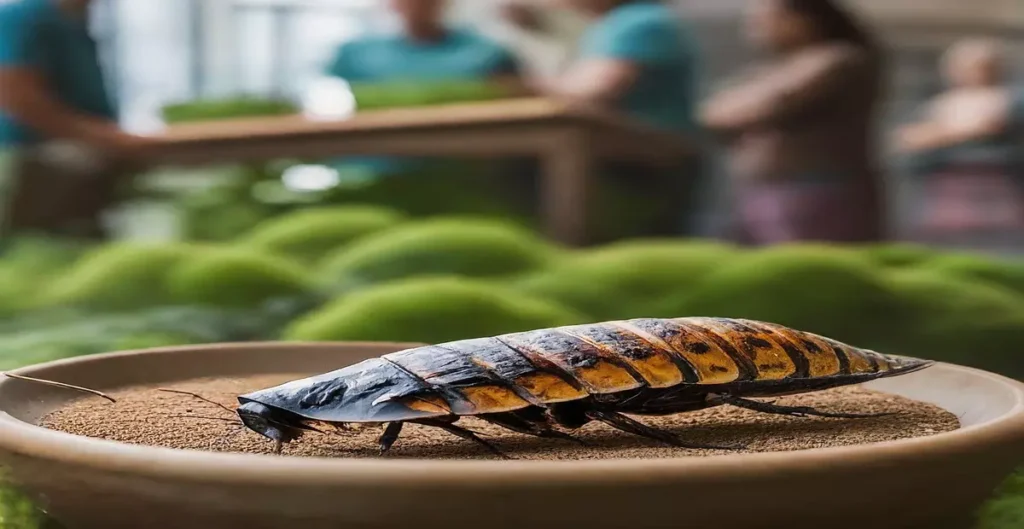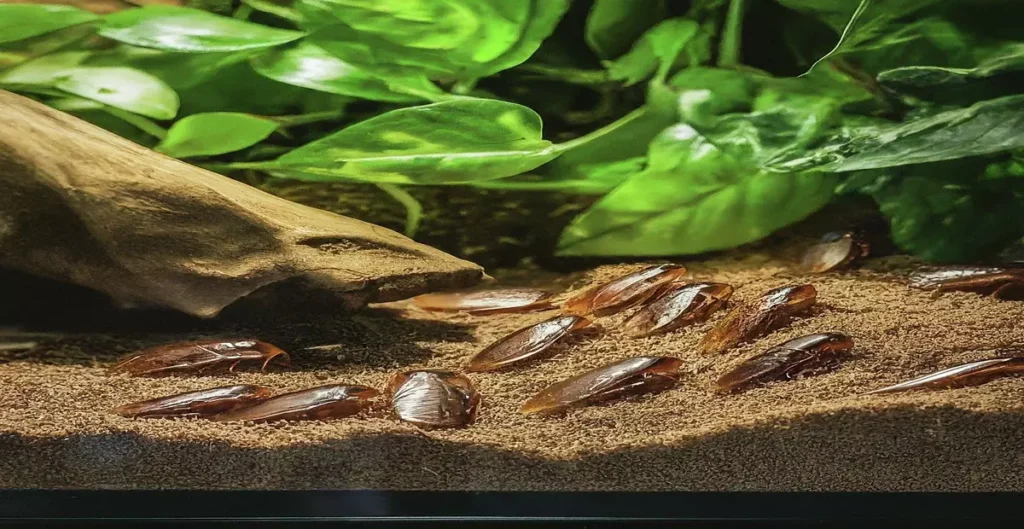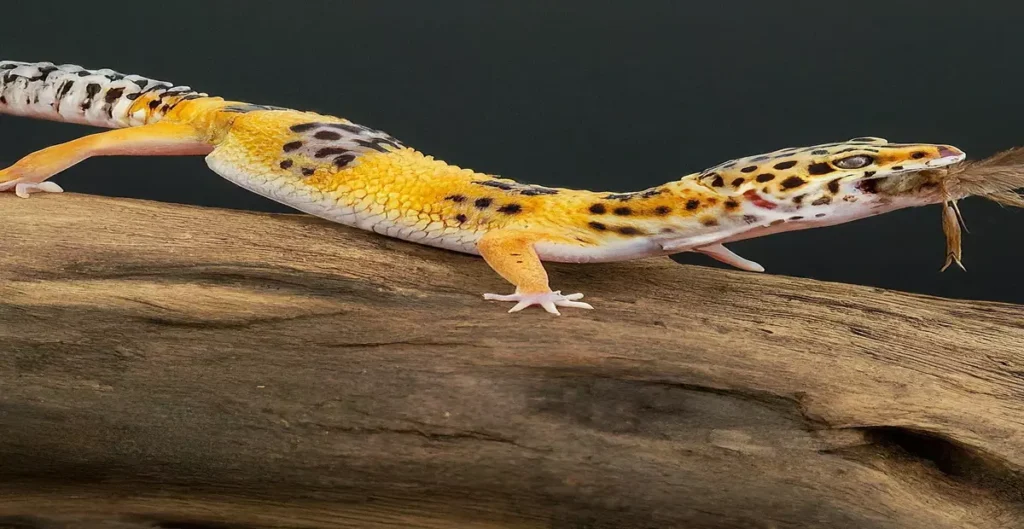Can Leopard Geckos Eat Dubia Roaches ? You Betcha!

Do you also has question in your mind, can leopard geckos eat dubia roaches? Then the answer is Yes, Absolutely! Dubia roaches are not only safe for your leopard gecko to munch on, but they’re actually considered one of the best feeder insects out there. Imagine tiny, protein-packed ninjas that are quiet, odorless, and escape-proof – that’s the magic of dubia roaches! But before we unleash your gecko’s inner ninja hunter, let’s delve into the why and how of feeding these fantastic feeders. Buckle up, reptile rookie, because we’re about to make you a dubia roach feeding pro in no time!
Unleashing the Dubia Delights
Why They’re Gecko Grub Gold (and How to Serve Them Right!)
Hold onto your crickets, reptile rookie, because we’re about to ditch the chirping chorus for a silent (and mightier) feast: dubia roaches. Yes, you read that right! These little protein powerhouses are quickly becoming the rockstar feeder insect for leopard geckos, and guess what? Your scaly pal is in for a treat!
But before we let your gecko unleash its inner ninja hunter, let’s break down the why and how of dubia roaches. Don’t worry, we’ll keep it fun and bite-sized (just like their snacks!).
Nutrient Ninjas: Power in Every Crunch
Forget about flimsy crickets and sluggish mealworms. Dubia roaches are packed with the good stuff your gecko needs to thrive. Think of them as miniature gym bags carrying:
- Protein Punch: Boasting a whopping 54% protein, dubia roaches are like muscle-building shakes for your gecko. This helps support growth, repair tissues, and keep those hunting instincts sharp.
- Calcium Champion: Unlike other feeders, dubia roaches come pre-loaded with calcium, a crucial mineral for strong bones and a healthy metabolism. No more dusting required! (But more on that later.)
- Vitamin Vault: They’re not just protein and calcium powerhouses! Dubia roaches also contain essential vitamins like A and D3, important for vision, immunity, and overall health.
Escape-Proof, Odorless, and (Almost) Silent: The Dream Feeder Team
Tired of crickets bouncing out of your tank and mealworms leaving smelly surprises? Say goodbye to those woes! Dubia roaches are:
- Escape Artists? Not a Chance: Forget Houdini impersonations. These roaches are flightless and climb-averse, keeping your tank escape-proof and your sanity intact.
- Silent Symphony: No more chirping serenades at 3 AM! Dubia roaches are practically silent, ensuring blissful peace for you and your gecko.
- Odor-Free Feast: Unlike some other feeders, dubia roaches won’t stink up your room. They’re clean and practically odorless, keeping your reptile haven smelling fresh.

Serving Up the Grub Glory
A Gecko Feeding Guide
Now that you’re convinced dubia roaches are the MVPs of gecko feeders, let’s talk about serving them right. Remember, it’s not just about throwing in some roaches and calling it a day. Here’s your roadmap to gecko feeding success:
Size Matters
Don’t overwhelm your gecko! Choose dubia roach sizes that match your little friend’s age and appetite. Think tiny nymphs for hatchlings and adult-sized roaches for grown-ups. A good rule of thumb: the roach shouldn’t be wider than the space between your gecko’s eyes.
Gut Loading
Supercharge Their Snack: Before offering them to your gecko, “gut load” your dubia roaches with nutritious foods like fruits, vegetables, and specially formulated feeder insect diets. This boosts their nutritional value, passing on the goodness to your gecko.
Presentation is Key
Spice up your gecko’s mealtime! Use tongs to offer the roach or place it in a shallow dish. This mimics natural hunting behavior and keeps your gecko engaged. Remember, gentle handling is key to avoiding stress.
Feeding Frequency
This depends on your gecko’s age and activity level. Young geckos might need daily feedings, while adults can eat every other day or even less. Monitor your gecko’s weight and adjust accordingly.
Bonus Tip: Dusting with calcium powder can still be beneficial, especially for growing geckos or egg-laying females. Just dust lightly after gut loading to avoid impaction.
Beyond the Basics: Gecko Grub FAQs
Ready to Unlock the Dubia Magic?
Armed with this knowledge, you’re now a dubia roach feeding pro! Remember, happy gecko, happy life. Provide a balanced diet with these nutritional powerhouses, and watch your scaly friend thrive and unleash its inner ninja hunter!

Feeding Techniques
Unleashing Your Gecko’s Inner Ninja (Without Turning Your Tank into a Roach Race!)
Now that you’ve discovered the wonders of dubia roaches as the ultimate gecko grub, it’s time to master the art of serving them up. Remember, it’s not just about tossing roaches in and calling it a day – we want to create a stimulating and enriching mealtime experience for your little hunter. Fear not, reptile rookie, for this guide will equip you with the ninja-approved feeding techniques to transform your tank into a gecko buffet fit for royalty (or at least, a very hungry lizard)!
Technique 1: The Tong Master
Channel your inner sushi chef and become a master of the feeding tongs! This method offers several benefits:
- Precision: You control the roach’s movement, mimicking natural hunting and keeping your gecko engaged.
- Hygiene: Avoids contaminating the tank with your hands, promoting good hygiene for both you and your gecko.
- Safety: Prevents accidental bites or injuries, especially important for young or skittish geckos.
Pro Tip: Gently wiggle the roach with the tongs to entice your gecko’s hunting instincts. Don’t force-feed – let your gecko initiate the chase and capture!
Technique 2: The Feeding Dish (with a Twist!)
While not as interactive as the tong method, feeding dishes can be a convenient option, especially for larger geckos. However, let’s add a twist to make it more exciting:
- Hide the Roaches: Scatter the roaches around the dish or partially bury them in substrate. This encourages your gecko to explore and forage, mimicking their natural hunting behavior.
- Variety is Key: Use different types of dishes and hiding spots to keep your gecko stimulated and prevent boredom.
Pro Tip: Monitor your gecko to ensure they’re finding all the roaches. If they seem to miss some, consider using the tong method for targeted feeding.
Pangea Ultimate Eco Dish

- Non-Toxic, Extremely Durable, Pet-Safe Silicone
- Dishwasher Safe
- Super easy to clean
Technique 3: The Scatter Hunt
This method encourages your gecko to explore and forage for their food, mimicking their natural hunting behavior in the wild. Here’s how:
- Scatter a small number of dubia roaches around the tank, ensuring they’re accessible to your gecko.
- Dim the lights slightly to create a dusk-like environment, which can stimulate hunting instincts.
- Observe your gecko as they explore and hunt for the roaches. This provides mental stimulation and enrichment.
Pro Tip: Start with this technique once your gecko is comfortable with tong feeding and has mastered the basic hunting skills.
Technique 4: The Obstacle Course
This method adds a playful twist to feeding time and encourages your gecko to problem-solve:
- Create a simple obstacle course using natural materials like rocks, branches, and leaves.
- Place the dubia roaches at the end of the obstacle course, rewarding your gecko for navigating the challenges to reach their food.
- This technique provides physical and mental stimulation, keeping your gecko active and engaged.
Pro Tip: Monitor your gecko closely to ensure they don’t get stuck or injured while navigating the obstacle course.
Technique 5: The Interactive Feeder
This method allows you to interact with your gecko during feeding time and build a stronger bond:
- Use a special feeder toy designed for dubia roaches. These toys often have compartments or tubes where the roaches can hide.
- Encourage your gecko to explore the feeder toy and extract the roaches, providing a fun and interactive experience.
- This technique can help reduce boredom and stress, promoting a positive relationship between you and your gecko.
Pro Tip: Choose a feeder toy that is the right size and complexity for your gecko’s age and abilities.
Remember, Regardless of the technique you choose, gentle handling is crucial. Avoid grabbing or chasing your gecko – let them approach the food at their own pace.
Bonus Tip: For young geckos or those transitioning to dubia roaches, you can initially offer pre-killed roaches to ease them into the new feeder. However, encourage live feeding as soon as your gecko is comfortable, as it provides enrichment and mental stimulation.
With these techniques and a sprinkle of patience, you’ll be a gecko feeding ninja in no time! Just remember, the key is to create a stress-free and enriching mealtime experience for your scaly friend. Now go forth and witness the joy of a gecko happily munching on their dubia roach bounty!

Taming Tiny Terrors
Addressing Dubia Roach Concerns (Like a True Gecko Guru!)
So, you’ve mastered the art of dubia roach feeding and your gecko is enjoying their protein-packed feasts. But hey, even the most enthusiastic reptile enthusiast might have a few lingering questions! Worry not, for this section addresses the most common concerns about dubia roaches, transforming you from a curious rookie into a confident gecko guru.
Concern 1: Parasite Panic! Are Dubia Roaches Risky?
Relax, reptile rookie! While any feeder insect can harbor parasites, the risk with properly sourced and cared-for dubia roaches is minimal. Here’s how to minimize the risk even further:
- Buy from reputable breeders: Opt for breeders who prioritize hygiene and parasite control in their colonies.
- Wash your hands: Always wash your hands thoroughly with soap and water after handling dubia roaches or their enclosure.
- Maintain a clean tank: Regularly clean your gecko’s tank and substrate to prevent parasite build-up.
Remember, These simple precautions greatly reduce the already low risk of parasite transmission.
Concern 2: Allergy Alert! What If My Gecko Reacts?
While rare, some geckos might develop allergies to dubia roaches. Signs to watch for include:
- Skin irritation (redness, bumps, swelling)
- Respiratory issues (wheezing, difficulty breathing)
- Lethargy or loss of appetite
If you notice any of these symptoms, stop feeding dubia roaches and consult your veterinarian immediately. They can help diagnose the allergy and suggest alternative feeder insects.
Concern 3: Overfeeding Frenzy! Can I Give My Gecko Too Much?
Absolutely! Like any good thing, overfeeding dubia roaches can lead to health problems for your gecko. Here’s how to avoid it:
- Follow feeding guidelines: Stick to recommended feeding frequencies based on your gecko’s age and activity level. Don’t free-feed!
- Monitor weight: Regularly weigh your gecko to track their growth and adjust feeding amounts if needed.
- Observe behavior: Watch your gecko’s eating habits. If they lose interest in food or seem lethargic, it might be a sign of overfeeding.
By following these tips, you can ensure your gecko enjoys the benefits of dubia roaches without the risks of overindulgence.
Bonus Tip: Consider offering a variety of feeder insects alongside dubia roaches for a balanced diet and to prevent boredom.
With this knowledge, you’re equipped to navigate any dubia roach concerns like a true gecko guru! Remember, responsible pet ownership means providing your scaly friend with proper nutrition and addressing any potential health issues promptly. Now go forth and conquer the world of dubia roaches with confidence!

Conclusion
Dubia Delights for a Thriving Gecko (Your Journey as a Pro Feeder Begins!)
Congratulations, reptile rookie! You’ve embarked on a fantastic journey, transforming from a curious newcomer into a confident dubia roach feeding pro. Remember, a well-nourished gecko is a happy gecko, and by incorporating these protein-packed powerhouses into their diet, you’re setting your scaly friend up for a healthy and thriving life.
Beyond the Grub
Remember, responsible pet ownership extends beyond just feeding. Here are some additional tips for a happy and healthy gecko:
- Provide proper housing: Choose a terrarium that meets your gecko’s size and species needs, offering adequate space, hiding spots, and temperature gradients.
- Maintain a clean environment: Regularly clean your gecko’s tank and substrate to prevent bacterial growth and promote overall health.
- Offer fresh water: Provide a shallow dish of clean, fresh water that’s readily accessible to your gecko.
- Schedule regular vet checkups: Annual checkups with your reptile veterinarian ensure your gecko’s health and well-being.
The Gecko Guru Community
Remember, you’re not alone! Join online forums, connect with other reptile enthusiasts, and continue learning and sharing your experiences. By supporting each other, we can create a thriving community of happy and healthy geckos!
So, are you ready to witness the transformation? Unleash the dubia roach bounty, observe your gecko’s newfound energy and hunting prowess, and bask in the satisfaction of providing the best possible care for your scaly companion. As your gecko thrives, you’ll know you’ve successfully unlocked the secrets of dubia roach feeding and become a true gecko guru!
Bonus Tip: Capture amazing photos and videos of your gecko enjoying their dubia roach feasts! Share them online and inspire others to join the world of responsible and rewarding reptile ownership.
Remember, the journey of learning and caring for your gecko is just beginning. Embrace the knowledge, celebrate the milestones, and most importantly, cherish the unique bond you share with your fascinating reptilian friend. Happy feeding!
